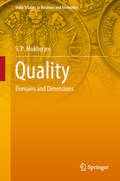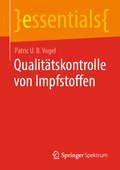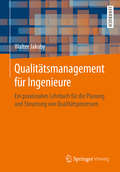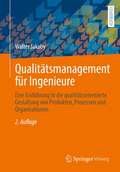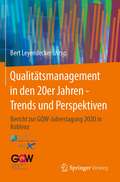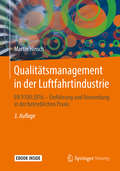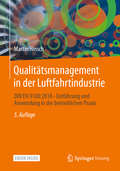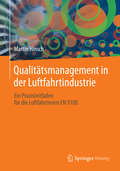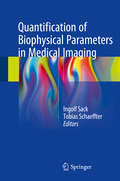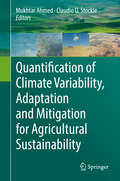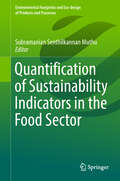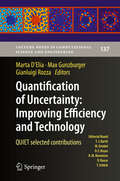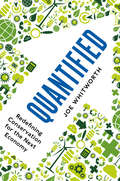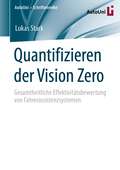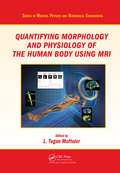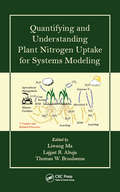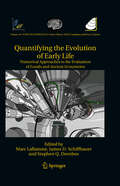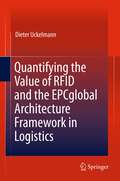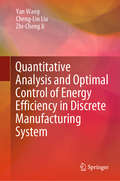- Table View
- List View
Quality: Domains and Dimensions (India Studies in Business and Economics)
by S. P. MukherjeeThis book offers a comprehensive overview of quality and quality management. It also explores total quality management, covering its human, technological and analytical imperatives. It also examines quality systems and system standards, highlighting essential features and avoiding a reproduction of the ISO 9000 standard, as well as people-related issues in implementing a quality system. A holistic understanding of quality considerations, which now permeate every aspect of human life, should guide related policies, plans and practices. The book describes the all-pervasive characteristics of quality, putting together diverse definitions of "quality," outlining its different dimensions, and linking it with reliability and innovation. It goes on to assess the quality of measurements in terms of precision, accuracy and uncertainty and discusses managing quality with a focus on business performance. This is followed by a chapter on improving process quality, which is the summum bonum of quality management, and a chapter addressing the crucial problem of measuring customer satisfaction through appropriate models and tools. Further, it covers non-traditional subjects such as quality of life, quality of working life, quality assurance and improvement in education, with special reference to higher education, quality in research and development and characterizes the quality-related policies and practices in Indian industry. The last chapter provides a broad sketch of some recent advances in statistical methods for quality management. Along with the research community, the book’s content is also useful for practitioners and industry watchers.
Qualitätskontrolle von Impfstoffen (essentials)
by Patric U. VogelIn diesem Buch wird die Qualitätskontrolle von Impfstoffen dargestellt. Hierzu zählen neben der Durchführung von analytischen Prüfungen verschiedenste qualitätsrelevante Aufgaben, z.B. die Festlegung von Qualitätsanforderungen, die Analyse von unerwarteten Ergebnissen oder Stabilitätsuntersuchungen, die die Qualitätskontroll-Einheit erfüllen muss. Die Abläufe sind hochreguliert und dienen der Patientensicherheit. Es gibt aber auch Beispiele, bei denen trotz erfolgreicher Qualitätskontrolle Qualitätsmängel möglich sind, die Schaden verursachen können.
Qualitätsmanagement für Ingenieure: Ein praxisnahes Lehrbuch für die Planung und Steuerung von Qualitätsprozessen
by Walter JakobyDie Methoden des QM und der Aufbau von ISO-9001-QMS werden in diesem Werk praxisnah vermittelt. Die elementaren Methoden dienen zum Lösen von Problemen, sowie zur Erfassung, Darstellung und Auswertung von Messreihen. Statistische Methoden wie SPC und die QRK ermöglichen den Umgang mit großen Produkt-Stückzahlen. QFD, FMEA und Poka Yoke unterstützen die anforderungsgerechte Gestaltung von Produkten und Prozessen. Anschließend wird beschrieben, wie aus vielen Einzelmethoden ein durchgängiges, ISO-9001-zertifiziertes QMS aufgebaut werden kann. Abschließend werden Six Sigma, Total Quality Management und Lean Management erläutert, die das Management von Unternehmen in qualitätsorientierter Sicht ausrichten.
Qualitätsmanagement für Ingenieure: Eine Einführung in die qualitätsorientierte Gestaltung von Produkten, Prozessen und Organisationen
by Walter JakobyDas Lehrbuch behandelt anschaulich und praxisnah die QM-Grundlagen. Alle wichtigen Methoden werden verständlich erklärt und in realistischen Beispielen angewendet. Das Buch beantwortet wichtige Fragen: Was ist Qualität? Wie kann sie erreicht werden? Das vorgestellte Methodenspektrum reicht vom Lösen von Problemen und zum Umgang mit Messdaten, über statistische Methoden der Qualitätsprüfung bis hin zur anforderungsgerechten Gestaltung der Produkte und Prozesse. Es wird gezeigt, wie aus den Einzelmethoden ein zertifiziertes QMS aufgebaut werden kann und wie sich ganze Unternehmen qualitätsorientiert ausrichten lassen.Das Buch ist für die vorlesungsbegleitende Verwendung, aber auch für das Selbststudium geeignet. Zusätzliche online-Unterlagen unterstützen die Einarbeitung und Anwendung.
Qualitätsmanagement in den 20er Jahren - Trends und Perspektiven: Bericht zur GQW-Jahrestagung 2020 in Koblenz
by Bert LeyendeckerZielsetzung der Gesellschaft für Qualitätswissenschaft e.V. ist es, die Qualitätswissenschaft in Lehre und Forschung zu fördern und den Wissenstransfer in die industrielle Anwendung zu unterstützen. Geschehen soll dies unter anderem durch Pflege des wissenschaftlichen Erfahrungsaustauschs unter den auf diesem Gebiet tätigen Personen und Institutionen und der Verbreitung von Forschungs- und Entwicklungsergebnissen sowie der Unterstützung des Wissenstransfers zwischen Forschung und Praxis. Unter dem Leitthema „Qualitätsmanagement in den 20er Jahren - Trends und Perspektiven“ hat die Gesellschaft für Qualitätsmanagement gemeinsam mit der Hochschule Koblenz zur GQW Tagung 2020 eingeladen. Wir freuen uns, dass wir Ihnen nun den zugehörigen Tagungsband vorstellen können. Wenn man nach den Trends der kommenden Jahre fragt, muss in vielen Branchen und Disziplinen fast zwingend die Digitalisierung genannt werden. So bildet dieses Thema auch einen starken Schwerpunkt in diesem Tagungsband. Die Beiträge beschäftigen sich mit künstlicher Intelligenz beim autonomen Fahren, der Rolle der Digitalisierung bei Nachweissystemen für Zusatzqualifikationen und Zutrittszertifikaten sowie der Integration von Industrie 4.0-Elementen in ganzheitlichen Produktionssystemen. Auch die Frage, welche Rolle die Blockchain-Technologie im Qualitätsmanagement spielen könnte, wird betrachtet. Eine weitere Facette bildet der Beitrag über den Einsatz von Eye-Tracking in der Produktentwicklung. Die aktuelle Corona-Krise wird ebenfalls aufgegriffen und erste Analysen zum Einfluss des digitalen Reifegrads auf das Arbeitszeitmodell in Krisenzeiten vorgestellt. Aber auch Beiträge zur Rolle von Erfahrungswissen im Qualitätsmanagement, zur Messung der Qualität in Produkt-Service-Systemen, zur ganzheitlichen Fehleranalyse, zu geometrischen Produktspezifikationen und Montagereihenfolgen finden Sie in diesem Band. Ein breiter Kanon spannender und aktueller Themen also, der zur Diskussion über das Qualitätsmanagement von morgen einlädt.
Qualitätsmanagement in der Luftfahrtindustrie
by Martin HinschDie Europäische Norm EN 9100 ist die branchenspezifische Norm der Luftfahrt-, Raumfahrt- und Verteidigungsindustrie. Für die Zusammenarbeit mit einem Luftfahrtkonzern gilt eine Zertifizierung der Zulieferer nach dieser Norm i.d.R. als obligatorisch.Das Buch unterstützt beim Verständnis und bei der betrieblichen Implementierung der Norm oder beim Umstieg von der ISO 9001 auf die EN 9100:2016. Nach einer Heranführung an die ISO 9001 im Allgemeinen und der EN 9100 im Speziellen wird auf die Schwerpunkte und Kerncharakteristika der EN 9100:2016 eingegangen. Das Buch richtet den Blickwinkel vor allem auf die Erläuterung und die Übersetzung des Normentextes in die Sprache des betrieblichen Alltags. Der Aufbau des Werkes orientiert sich dazu exakt am Aufbau der EN 9100:2016. Zahlreiche Praxisbeispiele erleichtern das Verständnis und die Implementierung im eigenen Unternehmen. Abschließend geht der Autor detailliert auf den Ablauf des Zertifizierungsprozesses ein. Dazu gehören die Vorbereitung, die Auswahl eines Zertifizierungsauditors und eines Zertifizierungsinstituts, die Auditdurchführung einschließlich Prozessmessung, die Abarbeitung von Beanstandungen sowie die Zertifikatsausstellung. Aufgrund hoher Deckungsgleichheit zwischen den Normen eignet sich dieses Buch auch als Ratgeber für die EN 9110 für Instandhaltungsbetriebe und die EN 9120 für Händler und Lagerhalter. In der 3. Auflage dieses erfolgreichen Ratgebers für die Luftfahrtindustrie sind bereits die Zertifizierungserfahrungen und Umsetzungsherausforderungen im Bereich der EN 9100:2016berücksichtigt. Des Weiteren wurden neue praktische Tipps für ein erfolgreiches Zertifizierungsaudit aufgenommen.
Qualitätsmanagement in der Luftfahrtindustrie: DIN EN 9100:2018 - Einführung und Anwendung in der betrieblichen Praxis
by Martin HinschDie Europäische Norm EN 9100 ist die branchenspezifische Norm der Luftfahrt-, Raumfahrt- und Verteidigungsindustrie. Für die Zusammenarbeit mit einem Luftfahrtkonzern gilt eine Zertifizierung der Zulieferer nach dieser Norm i.d.R. als obligatorisch.Das Buch unterstützt beim Verständnis und bei der betrieblichen Implementierung der Norm oder beim Umstieg von der ISO 9001 auf die EN 9100:2018. Nach einer Heranführung an die ISO 9001 im Allgemeinen und der EN 9100 im Speziellen wird auf die Schwerpunkte und Kerncharakteristika der EN 9100:2018 eingegangen. Das Buch richtet den Blickwinkel vor allem auf die Erläuterung und die Übersetzung des Normentextes in die Sprache des betrieblichen Alltags. Der Aufbau des Werkes orientiert sich dazu exakt am Aufbau der EN 9100:2018. Zahlreiche Praxisbeispiele erleichtern das Verständnis und die Implementierung im eigenen Unternehmen. Abschließend geht der Autor detailliert auf den Ablauf des Zertifizierungsprozesses ein. Dazu gehören die Vorbereitung, die Auswahl eines Zertifizierungsauditors und eines Zertifizierungsinstituts, die Auditdurchführung einschließlich Prozessmessung, die Abarbeitung von Beanstandungen sowie die Zertifikatsausstellung. Aufgrund hoher Deckungsgleichheit zwischen den Normen eignet sich dieses Buch auch als Ratgeber für die EN 9110 für Instandhaltungsbetriebe und die EN 9120 für Händler und Lagerhalter. In der 4. Auflage dieses erfolgreichen Ratgebers für die Luftfahrtindustrie wurden neue praktische Tipps für ein erfolgreiches Zertifizierungsaudit aufgenommen. Zudem wurden die wichtigsten Anforderungen zur EN 9120 für Händler und Lagerhalter in den Text integriert.Das Werk wendet sich an qualitätsverantwortliche Mitarbeiter bei Zulieferbetrieben der Luftfahrtindustrie.
Qualitätsmanagement in der Luftfahrtindustrie: DIN EN 9100:2018 - Einführung und Anwendung in der betrieblichen Praxis
by Martin HinschDie Europäische Norm EN 9100 ist die branchenspezifische Norm der Luftfahrt-, Raumfahrt- und Verteidigungsindustrie. Für die Zusammenarbeit mit einem Luftfahrtkonzern gilt eine Zertifizierung der Zulieferer nach dieser Norm i.d.R. als obligatorisch.Das Buch unterstützt beim Verständnis und bei der betrieblichen Implementierung der Norm oder beim Umstieg von der ISO 9001 auf die EN 9100:2018. Nach einer Heranführung an die ISO 9001 im Allgemeinen sowie an die EN 9100 und EN 9120 im Speziellen wird auf die Schwerpunkte und Kerncharakteristika der Luftfahrtnormen eingegangen. Das Buch richtet den Blickwinkel vor allem auf die Erläuterung und die Übersetzung des Normentextes in die Sprache des betrieblichen Alltags. Der Aufbau des Werkes orientiert sich dazu exakt am Aufbau der EN 9100:2018. Dazu werden, wo angebracht, auch Besonderheiten der Händlernorm EN 9120 thematisiert. Praxisbeispiele erleichtern das Verständnis und die Implementierung im eigenen Unternehmen. Abschließend geht der Autor detailliert auf den Ablauf des Zertifizierungsprozesses ein. Dazu gehören die Vorbereitung, die Auswahl eines Zertifizierungsauditors und eines Zertifizierungsinstituts, die Auditdurchführung einschließlich Prozessmessung, die Abarbeitung von Beanstandungen sowie die Zertifikatsausstellung. Aufgrund hoher Deckungsgleichheit zwischen den Normen eignet sich dieses Buch auch als Ratgeber für die EN 9110 für Instandhaltungsbetriebe und die EN 9120 für Händler und Lagerhalter. In der 5. Auflage dieses erfolgreichen Ratgebers für die Luftfahrtindustrie wurden praktische Tipps für ein erfolgreiches Zertifizierungsaudit ergänzt und neueste Zertifizierungserfahrungen mit der EN 9100:2018 aufgenommen.
Qualitätsmanagement in der Luftfahrtindustrie: Die EN 9100:2016 verständlich erklärt
by Martin HinschDie 2. Auflage dieses erfolgreichen Ratgebers für die Luftfahrtindustrie erläutert detailliert die Anforderungen der neuen EN 9100:2016 und gibt überdies praktische Tipps für ein erfolgreiches Zertifizierungsaudit.Die Europäische Norm EN 9100 ist die branchenspezifische Norm der Luft-, Raumfahrt- und Verteidigungsindustrie. Für die Zusammenarbeit mit einem Luftfahrtkonzern gilt eine Zertifizierung der Zulieferer nach dieser Norm i.d.R. als obligatorisch.Das Buch unterstützt beim Verständnis und bei der betrieblichen Implementierung der Norm sowie bei der Anpassung an die Anforderungen der neuen EN 9100:2016. Nach einer Heranführung an die ISO 9001 im Allgemeinen und der EN 9100 im Speziellen wird auf die wesentlichen Änderungen der 2016er Normenrevision sowie auf Schwerpunkte und Kerncharakteristika der EN 9100:2016 eingegangen. Das Buch richtet den Blickwinkel vor allem auf die Erläuterung und die Übersetzung des Normentextes in die Sprache des betrieblichen Alltags. Der Aufbau des Werkes orientiert sich dazu exakt am Aufbau der EN 9100:2016. Zahlreiche Praxisbeispiele erleichtern das Verständnis und die Implementierung im eigenen Unternehmen. Jedem Kapitel ist eine Infobox vorangestellt, in der die Änderungen zur alten EN 9100:2009 aufgeführt werden.Abschließend geht der Autor detailliert auf den Ablauf des Zertifizierungsprozesses ein. Dazu gehören die Vorbereitung, die Auswahl eines Zertifizierungsauditors und eines Zertifizierungsinstituts, die Auditdurchführung einschließlich Prozessmessung, die Abarbeitung von Beanstandungen sowie die Zertifikatsausstellung. Aufgrund hoher Deckungsgleichheit zwischen den Normen eignet sich dieses Buch auch als Ratgeber für die neue EN 9110 und EN 9120.
Qualitätsmanagement in der Luftfahrtindustrie: Ein Praxisleitfaden für die Luftfahrtnorm EN 9100
by Martin HinschDie Europäische Norm EN 9100 ist die branchenspezifische Norm der Luft-, Raumfahrt- und Verteidigungsindustrie. Für die Zusammenarbeit mit einem Luftfahrtkonzern gilt eine Zertifizierung der Zulieferer nach dieser Norm i.d.R. als obligatorisch.Das Buch unterstützt beim Verständnis und bei der betrieblichen Implementierung der Norm. Nach einer Heranführung an die Grundlagen von Zertifizierungen nach ISO 9001 im Allgemeinen und der EN 9100 im Speziellen werden die Schwerpunkte und Kerncharateristika der EN 9100 dargestellt. Der Autor geht detailliert auf den Ablauf des Zertifizierungsprozesses mit Vorbereitung, die Auswahl eines Zertifizierungsauditors und eines Zertifizierungsinstituts, Auditdurchführung, Abarbeitung von Beanstandungen und Zertifikatsausstellung ein.Den Schwerpunkt des Buches bilden die Erläuterung und Übersetzung des Normentextes in die Sprache des betrieblichen Alltags. Der Aufbau des Werkes orientiert sich dazu exakt am Aufbau der EN 9100. Zahlreiche Praxisbeispiele erleichtern die Implementierung im eigenen Unternehmen. Den Kapiteln ist ein Anhang mit über 150 typischen Auditbeanstandungen aus der tätglichen Zertifizierungspraxis angefügt.
Quantenkommunikationsnetze
by Frank H. Fitzek Holger Boche Christian Deppe Riccardo Bassoli Roberto Ferrara Gisbert Janssen Sajad SaeedinaeeniDieses Buch bietet ein Tutorial über Quantenkommunikationsnetze. Die Autoren erörtern aktuelle Paradigmenwechsel in Kommunikationsnetzen, die erforderlich sind, um die einfachen Transportkonzepte der vorherrschenden Netze um Rechen- und Speicherfunktionen zu ergänzen. Sie zeigen, wie diese "softwarisierten" Lösungen neue Wege beschreiten, um Latenzzeiten zu reduzieren und die Ausfallsicherheit zu erhöhen. Die Autoren erörtern, wie diese Lösungen trotz der ihnen innewohnenden Probleme aufgrund der eingeführten Rechenlatenz und des Energieverbrauchs durch hybride klassisch-quantische Kommunikationsnetze gelöst werden können. Das Buch bringt Quantennetzwerke, Quanteninformationstheorie, Quantencomputer und Quantensimulation zusammen.
Quantification of Biophysical Parameters in Medical Imaging
by Ingolf Sack Tobias SchaeffterThis book provides a selection of essential knowledge on the image-based quantification of biophysical parameters for the purpose of clinical diagnosis. The authors regard clinical imaging scanners as physical measurement systems capable of quantifying intrinsic parameters for depiction of the constitution and biophysical properties of in vivo tissue. On the one hand, this approach supports the development of new methods of imaging highly reproducible, system-independent, and quantitative biomarkers, and these methods receive detailed attention in the book. On the other hand, the reader will also gain a deeper understanding of how physical tissue properties interact with the generation of signals in medical imaging, opening new windows on the intricate and fascinating relationship between the structure and function of living tissues. The book will be of interest to all who recognize the limitations of basing clinical diagnosis primarily on visual inspection of images and who wish to learn more about the diagnostic potential of quantitative and biophysics-based medical imaging markers and the challenges that the paucity of such markers poses for next-generation imaging technologies.
Quantification of Climate Variability, Adaptation and Mitigation for Agricultural Sustainability
by Mukhtar Ahmed Claudio O. StockleThis book is a comprehensive volume dealing with climate change impacts on agriculture, and which can help guide the redesign of agricultural management and cropping systems. It includes mitigation techniques such as use of bioenergy crops, fertilizer and manure management, conservation tillage, crop rotations, cover crops and cropping intensity, irrigation, erosion control, management of drained wetlands, lime amendments, residue management, biochar and biotechnology. It also includes Management of GHG emissions Crop models as decision support tools QTL analysis Crop water productivity Impacts of drought on cereal crops Silvopastoral systems Changing climate impact on wheat-based cropping systems of South Asia Phosphorous dynamics under changing climate Role of bioinformatics The focus of the book is climate change mitigation to enhance sustainability in agriculture. We present various kinds of mitigation options, ways to minimize GHG emissions and better use of the latest techniques in conservation and environmental-sustainability.
Quantification of Contrast Kinetics in Clinical Imaging (SpringerBriefs in Applied Sciences and Technology)
by Osama I. Soliman Folkert J. ten Cate Massimo Mischi Simona Turco Hessel Wijkstra Ivo SchootsThis book provides a comprehensive survey of the pharmacokinetic models used for the quantitative interpretation of contrast-enhanced imaging. It discusses all the available imaging technologies and the problems related to the calibration of the imaging system and accuracy of the estimated physiological parameters. Enhancing imaging modalities using contrast agents has opened up new opportunities for going beyond morphological information and enabling minimally invasive assessment of tissue and organ functionality down to the molecular level. In combination with mathematical modeling of the contrast agent kinetics, contrast- enhanced imaging has the potential to provide clinically valuable additional information by estimating quantitative physiological parameters. The book presents the broad spectrum of diagnostic possibilities provided by quantitative contrast-enhanced imaging, with a particular focus on cardiology and oncology, as well as novel developments in the area of quantitative molecular imaging along with their potential clinical applications. Given the variety of available techniques, the choice of the appropriate imaging modality and the most suitable pharmacokinetic model is often challenging. As such, the book provides a valuable technical guide for researchers, clinical scientists, and experts in the field who wish to better understand and properly apply tracer-kinetic modeling for quantitative contrast-enhanced imaging.
Quantification of Sustainability Indicators in the Food Sector (Environmental Footprints And Eco-design Of Products And Processes)
by Subramanian Senthilkannan MuthuThis book highlights various methods of quantifying sustainability indicators in the food sector, highlighting the environmental indicators in the meat chain and agri-food wastes from a bio-refinery perspective. Numerous sustainability indicators that encompass all three pillars – economic, environmental and social areas – as well as individual and joint indicators (e.g. environmental and social) have been developed and quantified to date. Some of these indicators can be utilised for any industrial sector, while others are sector-specific. Behind each indicator developed, there is a unique scientific model, method or assessment technique. This book enumerates these indicators, providing details such as the concept, development methodology, assessment technique, and applications, mainly in the food industry.
Quantification of Uncertainty: QUIET selected contributions (Lecture Notes in Computational Science and Engineering #137)
by Gianluigi Rozza Marta D’Elia Max GunzburgerThis book explores four guiding themes – reduced order modelling, high dimensional problems, efficient algorithms, and applications – by reviewing recent algorithmic and mathematical advances and the development of new research directions for uncertainty quantification in the context of partial differential equations with random inputs. Highlighting the most promising approaches for (near-) future improvements in the way uncertainty quantification problems in the partial differential equation setting are solved, and gathering contributions by leading international experts, the book’s content will impact the scientific, engineering, financial, economic, environmental, social, and commercial sectors.
Quantified
by Joe WhitworthGoogle, Apple, Amazon, Uber: companies like these have come to embody innovation, efficiency, and success. How often is the environmental movement characterized in the same terms? Sadly, conservation is frequently seen as a losing battle, waged by well-meaning, but ultimately ineffective idealists. Joe Whitworth argues it doesn't have to be this way. In fact, it can't be this way if we are to maintain our economy, let alone our health or the planet's. In Quantified, Whitworth draws lessons from the world's most tech-savvy, high-impact organizations to show how we can make real gains for the environment. The principles of his approach, dubbed quantified conservation, will be familiar to any thriving entrepreneur: situational awareness, bold outcomes, innovation and technology, data and analytics, and gain-focused investment. This no-nonsense strategy builds on the inspirational environmental work begun in the 1970s, while recognizing that the next economy will demand new solutions. As President of The Freshwater Trust, Whitworth has put quantified conservation into practice, pioneering the model of a "do-tank" that is dramatically changing how rivers can get restored across the United States. The stories in Quantified highlight the most precious of resources--water--but they apply to any environmental effort. Whether in the realm of policy, agriculture, business, or philanthropy, Whitworth is charting a new course for conservation.
Quantified: Biosensing Technologies in Everyday Life
by Dawn NafusWhat is at stake socially, culturally, politically, and economically when we routinely use technology to gather information about our bodies and environments? Today anyone can purchase technology that can track, quantify, and measure the body and its environment. Wearable or portable sensors detect heart rates, glucose levels, steps taken, water quality, genomes, and microbiomes, and turn them into electronic data. Is this phenomenon empowering, or a new form of social control? Who volunteers to enumerate bodily experiences, and who is forced to do so? Who interprets the resulting data? How does all this affect the relationship between medical practice and self care, between scientific and lay knowledge? Quantified examines these and other issues that arise when biosensing technologies become part of everyday life.The book offers a range of perspectives, with views from the social sciences, cultural studies, journalism, industry, and the nonprofit world. The contributors consider data, personhood, and the urge to self-quantify; legal, commercial, and medical issues, including privacy, the outsourcing of medical advice, and self-tracking as a “paraclinical” practice; and technical concerns, including interoperability, sociotechnical calibration, alternative views of data, and new space for design.ContributorsMarc Böhlen, Geoffrey C. Bowker, Sophie Day, Anna de Paula Hanika, Deborah Estrin, Brittany Fiore-Gartland, Dana Greenfield, Judith Gregory, Mette Kragh-Furbo, Celia Lury, Adrian Mackenzie, Rajiv Mehta, Maggie Mort, Dawn Nafus, Gina Neff, Helen Nissenbaum, Heather Patterson, Celia Roberts, Jamie Sherman, Alex Taylor, Gary Wolf
Quantifizieren der Vision Zero: Gesamtheitliche Effektivitätsbewertung von Fahrerassistenzsystemen (AutoUni – Schriftenreihe #165)
by Lukas StarkModerne Fahrzeuge sind mit einer Vielzahl an elektronischen Systemen ausgestattet, die unter anderem dazu beitragen, die Verkehrssicherheit zu erhöhen. Die vorliegende Arbeit befasst sich mit der Untersuchung der Wirksamkeit von Fahrerassistenzsystemen und automatischen Fahrfunktionen hinsichtlich der Vermeidung von schweren Verkehrsunfällen. Die entwickelte gesamtheitliche Methodik zur Effektivitätsbewertung adressiert folgende Themenschwerpunkte: Bewertungsmethodik, Datengrundlage und Integration der zu bewertenden Systeme in die Bewertungsumgebung.
Quantifying Morphology and Physiology of the Human Body Using MRI (Series in Medical Physics and Biomedical Engineering)
by L. Tugan MuftulerIn the medical imaging field, clinicians and researchers are increasingly moving from the qualitative assessment of printed images to the quantitative evaluation of digital images since the quantitative techniques often improve diagnostic accuracy and complement clinical assessments by providing objective criteria. Despite this growing interest, th
Quantifying and Understanding Plant Nitrogen Uptake for Systems Modeling
by Liwang Ma Lajpat R. Ahuja Tom BruulsemaDiscusses New Advancements to Improve Existing Simulations of Plant NitrogenWritten by research pioneers and leading scientists in the area of agricultural systems, Quantifying and Understanding Plant Nitrogen Uptake for Systems Modeling comprehensively covers plant N uptake in agricultural system models, especially for building soil-plant system m
Quantifying the Evolution of Early Life
by James D. Schiffbauer Marc Laflamme Stephen Q. DornbosThis volume provides a detailed description of a wide range of numerical, statistical or modeling techniques and novel instrumentation separated into individual chapters written by paleontologists with expertise in the given methodology. Each chapter outlines the strengths and limitations of specific numerical or technological approaches, and ultimately applies the chosen method to a real fossil dataset or sample type. A unifying theme throughout the book is the evaluation of fossils during the prologue and epilogue of one of the most exciting events in Earth History: the Cambrian radiation.
Quantifying the Value of RFID and the EPCglobal Architecture Framework in Logistics
by Dieter UckelmannThe "EPCglobal Architecture Framework" is currently the most accepted technical approach to the Internet of Things and provides a solid foundation for building Business-to-Business information networks based on unique identifications of 'things'. Lately, the vision of the Internet of Things has been extended to a more holistic approach that integrates sensors as well as actuators and includes non-business stakeholders. A detailed look at the current state of the art in research concerning cost and benefit estimations is provided and the limits of Cost Benefit Sharing for RFID-based IT-infrastructures are explained. In this work a market driven evaluation based on sales potential of information is developed. Simple technical means for aggregation of micro values to a billable amount are discussed. The requirements for electronic billing infrastructure are defined and a matching e-billing solutions for an evaluation scenario is presented, providing a technical infrastructure to evaluate and bill product-related information in a future Internet of Things, based on an extended EPCglobal Architecture. Further opportunities and threats are discussed to provide an overview of its future potential. As a result it will contribute to the sustainable success of the Internet of Things itself.
Quantitative Analysis and Optimal Control of Energy Efficiency in Discrete Manufacturing System
by Yan Wang Cheng-Lin Liu Zhi-Cheng JiThis book provides energy efficiency quantitative analysis and optimal methods for discrete manufacturing systems from the perspective of global optimization. In order to analyze and optimize energy efficiency for discrete manufacturing systems, it uses real-time access to energy consumption information and models of the energy consumption, and constructs an energy efficiency quantitative index system. Based on the rough set and analytic hierarchy process, it also proposes a principal component quantitative analysis and a combined energy efficiency quantitative analysis. In turn, the book addresses the design and development of quantitative analysis systems. To save energy consumption on the basis of energy efficiency analysis, it presents several optimal control strategies, including one for single-machine equipment, an integrated approach based on RWA-MOPSO, and one for production energy efficiency based on a teaching and learning optimal algorithm. Given its scope, the book offers a valuable guide for students, teachers, engineers and researchers in the field of discrete manufacturing systems.
Quantitative Analysis of Cellular Drug Transport, Disposition, and Delivery (Methods in Pharmacology and Toxicology)
by Gus R. Rosania Greg M. ThurberThis thorough book explores some of the most important methods and concepts affecting the quantitative analysis of the transport, targeting, and disposition of chemicals within cells, which in turn impact the macroscopic pharmacokinetics of chemical agents in the whole organism. The first half of the volume focuses on small organic molecules with drug-like characteristics, while the second half delves into the cellular pharmacokinetics of biologics and other macromolecules, including peptide therapeutics, cyclotides, antibodies, as well as nanoparticles, thus creating a comprehensive treatise that approaches cellular pharmacokinetics from the different perspectives of pharmaceutical scientists, chemical biologists, medicinal chemists, and protein engineers dealing with very different chemical agents spanning a wide range of sizes, physicochemical properties, and targeting mechanisms. Written for the Methods in Pharmacology and Toxicology series, chapters provide the kind of key detail and expert implementation advice that leads to excellent results in the lab. Synthetic biologists, biophysicists, and bioengineers are amongst the long list of scientists who could benefit from reading this book or from using it as a textbook. Authoritative and practical, Quantitative Analysis of Cellular Drug Transport, Disposition, and Delivery builds on a long history of drug development and the adding of quantitative methods at the cellular scale in order to inspire new approaches to drug development that are better able to take advantage of phenomena such as soluble-to-insoluble phase transitions or bispecific targeting, which could ultimately be exploited for the development of more effective drug delivery systems and therapeutic agents.
